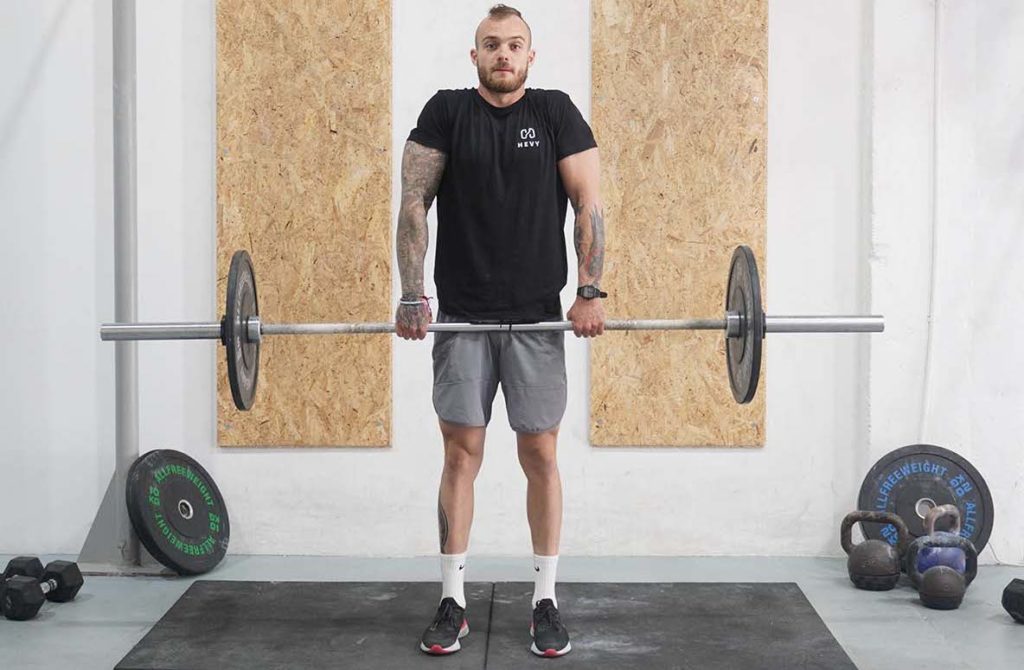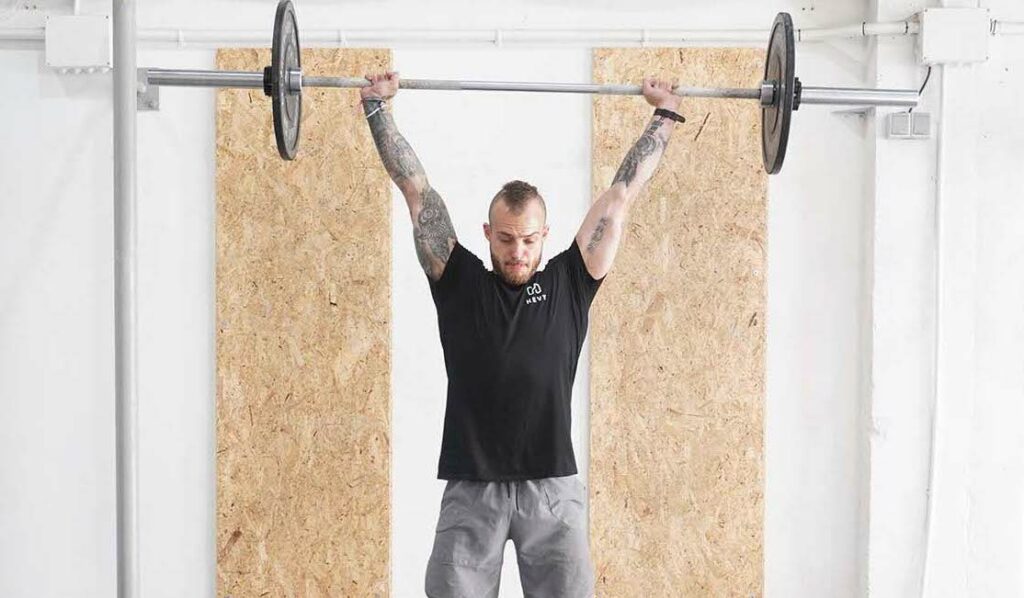What is the Clean Pull?
People often go about building strength and power separately. But the truth is, you don’t have to split your training and complicate things unnecessarily. Exercises like the clean pull work great because they mix different training elements and develop multiple athletic characteristics. They work on building strength first and later leverage that to build power and explosiveness.
The clean pull is a three-stage movement that forces you to produce a lot of force quickly. As a result, you train many muscle groups simultaneously, build whole-body strength, and become more explosive. Because of that, clean pulls improve your athletic performance, make you stronger, and could even benefit your daily life.
How to do a Clean Pull

- Stand in front of a loaded barbell, similar to how you would for a deadlift. Your feet should be hip-width apart, and the barbell should be over the mid-foot.
- Your back should be neutral with your chest out and arms to your sides.
- Bend forward and grab the barbell with an even overhand grip at shoulder-width distance.
- Bring your shoulders back as much as you can to straighten your back, bring your shins against the bar, and pull the slack off the barbell.
- Take a breath and initiate the pull by digging your heels into the floor.
- Extend your hips and knees as you maintain your neutral back position.
- As the barbell travels up, extend your knees with your hips.
- Once the barbell goes over your knees, initiate the second stage by forcefully pressing your heels into the floor as if you were trying to do a vertical jump.
- As the barbell keeps traveling up, forcefully drive your hips forward, fully extending your ankles, knees, and hips. While doing so, shrug your shoulders to raise the bar even more – it should go slightly above your waist.
- Lower the barbell slowly by first bringing your glutes back. Keep your chest out and back straight.
What muscles does the clean pull activate?
Clean pulls emphasize your entire posterior chain (1). Specifically, the exercise works your hamstrings, glutes, and erector spinae. Your hamstrings and glutes work hard to produce hip extension while your erector spinae contract to keep your back neutral. The movement also works your quadriceps. As you begin to raise the barbell, your quadriceps extend your knees, allowing your legs to become straight at the top position.
Clean pulls also involve your entire upper back musculature: rhomboids, latissimus dorsi, trapezius, and other muscles. These muscles keep you in position, and your trapezius gets more involved near the top as you shrug the barbell up.
Your abs, obliques, and transverse abdominis also work hard to keep you in a stable position as you lift and lower the barbell. Finally, we have your shoulders, biceps, and forearms. These muscles play an essential role in holding onto the weight, making the clean pull a fantastic full-body activity.
What is the difference between Clean Pull and Deadlift?
The bar speed and execution is the most notable difference between clean pulls and deadlifts. With deadlifts, the goal is a slow and controlled repetition where the barbell travels in a straight vertical line (2). Clean pulls have you use much more explosiveness to propel the barbell up. Also, unlike deadlifts, the weight travels in an “S” pattern (first pulling toward your body, then moving it slightly away, and bringing it back in for the finish).
The clean pull also has a slightly different starting position. Specifically, your torso must be a bit more upright, so your hips must be lower (1). In contrast, deadlifts have you keep your hips slightly higher and knees a bit more extended. As a result, you can engage your quadriceps better and force a more explosive initial pull of the barbell.
Variations and Modifications of the Clean Pull
1. Clean High Pull
The clean high pull is a variation of the regular exercise where you attempt to lift the bar even higher. To do that, you must keep pulling the barbell straight up, following the initial two vertical thrusts. Clean high pulls are beneficial for reinforcing a more assertive and explosive execution of the movement, leading to better shoulder, trap, and bicep involvement.
2. Block Clean Pull
The block clean pull is a variation where you elevate the barbell on blocks and only do the top half of the range of motion. This variation is beneficial for practicing the final extension without becoming too tired.
3. Clean Pull Hold
The clean pull hold is a variation where you hold the shoulder shrug position for two to five seconds. The movement is good for reinforcing balance, working your back more, and emphasizing complete extension.
Mistakes to Avoid
A common mistake to avoid with clean pulls is using too much weight. In doing so, you can’t accelerate the barbell off the floor and essentially turn the movement into a deadlift. You should practice clean pulls with less weight to achieve good speed and explosiveness in one smooth motion.
Another mistake to watch out for is turning the clean pull into a deadlift with a shrug on top. Clean pulls are about accelerating the bar off the floor and accelerating it again at thigh level, allowing you to use the momentum to raise it a few extra inches at the top. The movement should feel like a single unit, not as separate exercises bundled together.
The last common mistake to avoid relates to the initial setup. People new to the movement often approach it as they do a deadlift, which isn’t necessarily bad, but it’s not ideal. With clean pulls, your hips have to be lower, and your torso has to be more upright. The position will allow you to turn the initial pull more into a squat than a hip hinge. In doing so, you can engage your quadriceps better and generate enough force to accelerate the barbell.
Similar Exercises to the Clean Pull
Deadlift

Deadlifts are similar to clean pulls because both movements take advantage of hip extension and activate many of the same muscle groups (1, 3). The differences stem from the initial setup, the load used, and the speed of execution. As a result, deadlifts develop maximal strength, whereas clean pulls build explosiveness.
Shrug (Barbell)

Barbell shrugs are essentially the final portion of the clean pull. As you lift the weight off the floor and raise it to your upper thigh area, shrugging is what allows you to raise the barbell a few extra inches.
Snatch Pull

Snatch pulls are similar to clean pulls in terms of the range of motion, objective, and execution. The primary difference is, snatch pulls are primarily used to help lifters master the extension on their way to a perfect snatch. With snatch pulls, your grip on the barbell is also much wider.

